20 Types of Ducks in Illinois (with Pictures)
Last Updated on
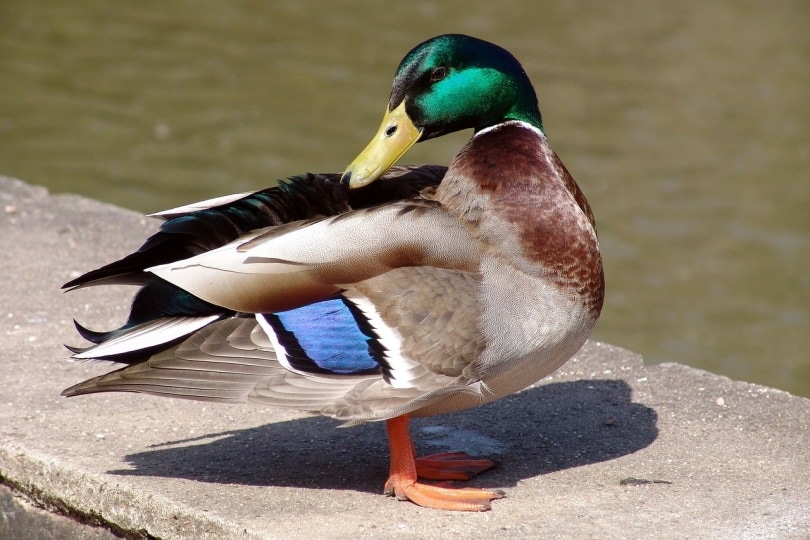
Many ducks fly across Illinois during their migrations. You can actually see about 20 different duck breeds in Illinois throughout the year. Even some rare species will make an annual appearance in the state.
Check out our list of duck breeds to see if you’ve encountered any of them in the Prairie State. We’ve also ranked their rarity with three categories: Common, uncommon, and rare.

The 20 Duck Breeds in Illinois:
1. American Black Duck
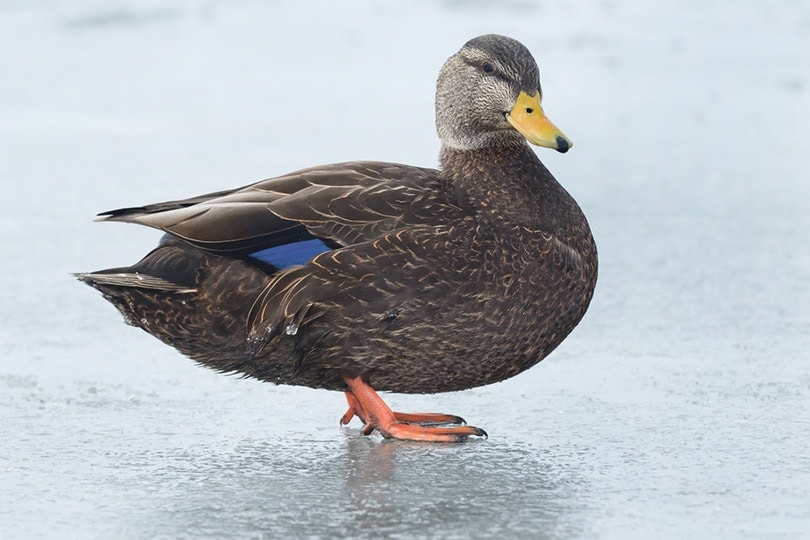
| Rarity: | Common |
| Type: | Dabbling Duck |
The American Black Duck winters all throughout Illinois near shallow wetlands. Male American Black Ducks have yellow bills, brown bodies, and a streak of blue-violet wing feathers.
The females have dark brown bodies and duller colored bills. They often get mistaken with female Mallards and can also crossbreed with Mallards.
2. American Wigeon Duck
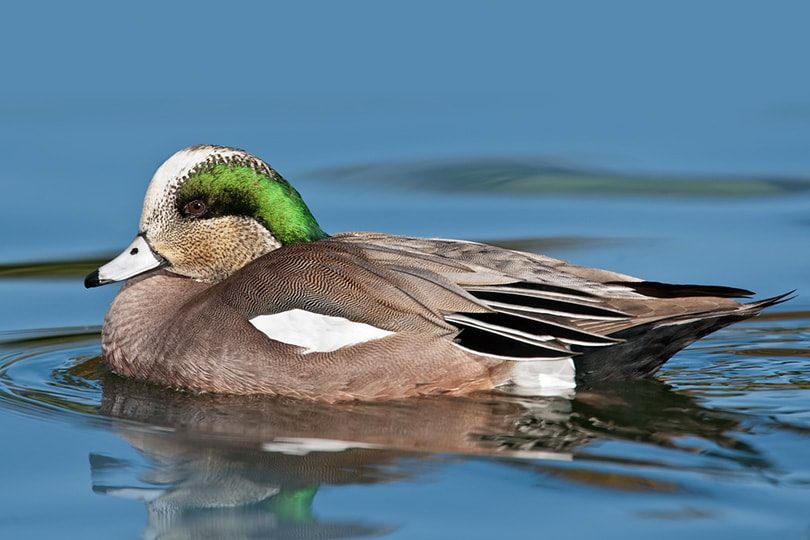
| Rarity: | Rare |
| Type: | Dabbling Duck |
You can find glimpses of the American Wigeon seasonally. These ducks migrate from the north and sometimes winter in Southern Illinois.
The males have a green and white head with a blue-gray bill. Their bodies are brown with black tail feathers, and they have a distinctive white spot on their shoulder wing. The females are mottled brown with black tail feathers.
These timid ducks prefer isolated lakes and marshes with very little foot traffic, so it can be difficult to spot them.
3. Blue-Winged Teal Duck
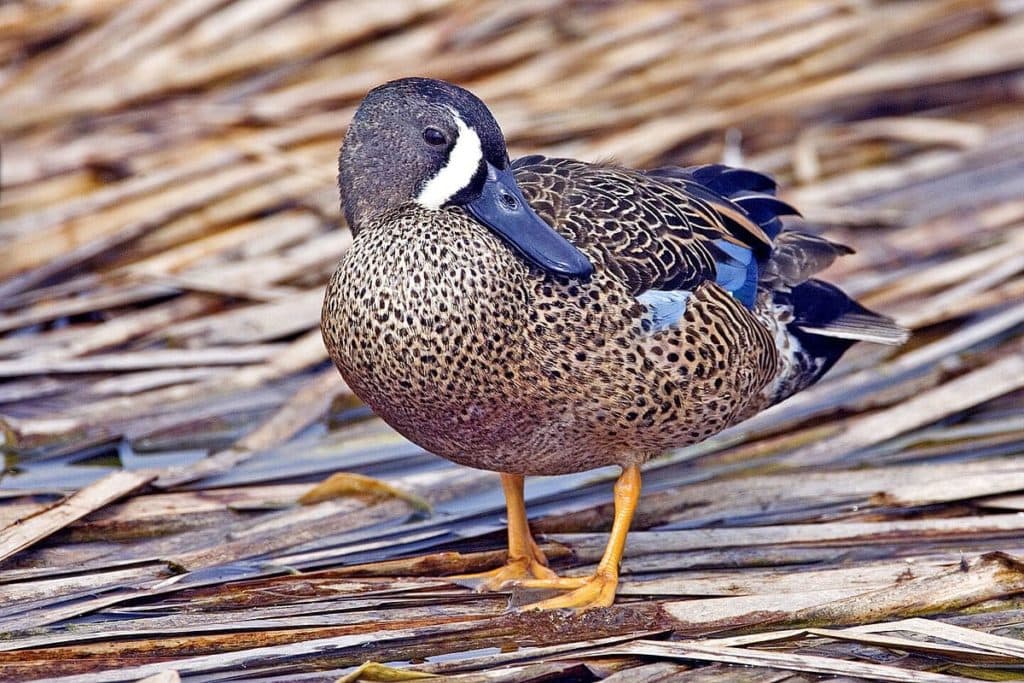
| Rarity: | Common |
| Type: | Dabbling Duck |
The Blue-Winged Teal can be found in Central and Northern Illinois during the summer. You can start to see them further south as they migrate to Central America for the winter. They prefer to live near ponds and lakes and like to eat snails and aquatic plants and insects.
The males have bluish heads with a vertical streak of white in between their black bills and eyes. They also have a patch of pale blue wing feathers. The females don’t have the white streak but share the blue wing feathers that males have.
4. Bufflehead Duck
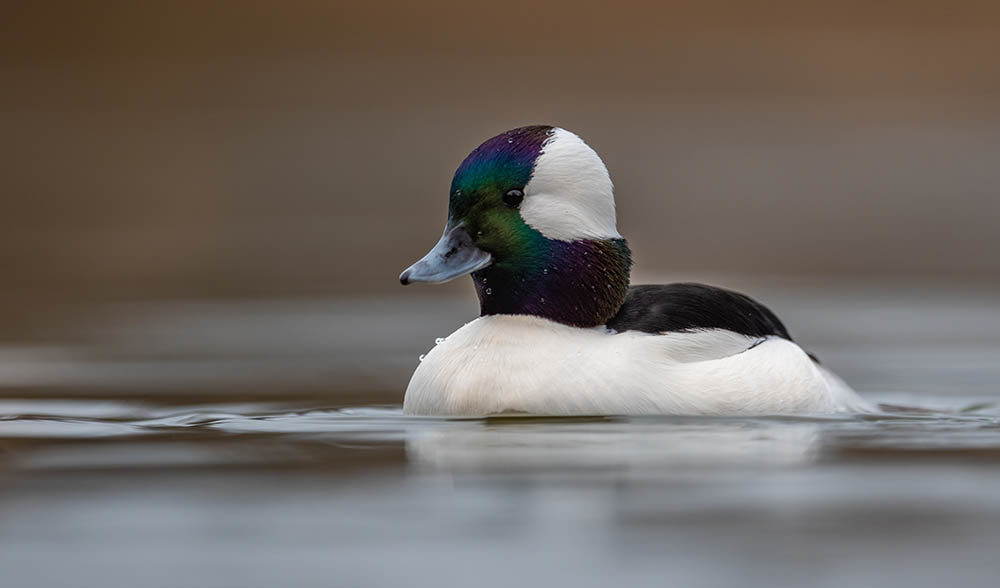
| Rarity: | Uncommon |
| Type: | Diving Duck |
These ducks become a more common sight to see in the colder months when some choose to winter all throughout Illinois. These diving ducks love to eat fish and other small invertebrates.
The males have white and black heads with black bills, and their bodies are white on the bottom and black on top. Females are black, white, and gray.
5. Canvasback Duck
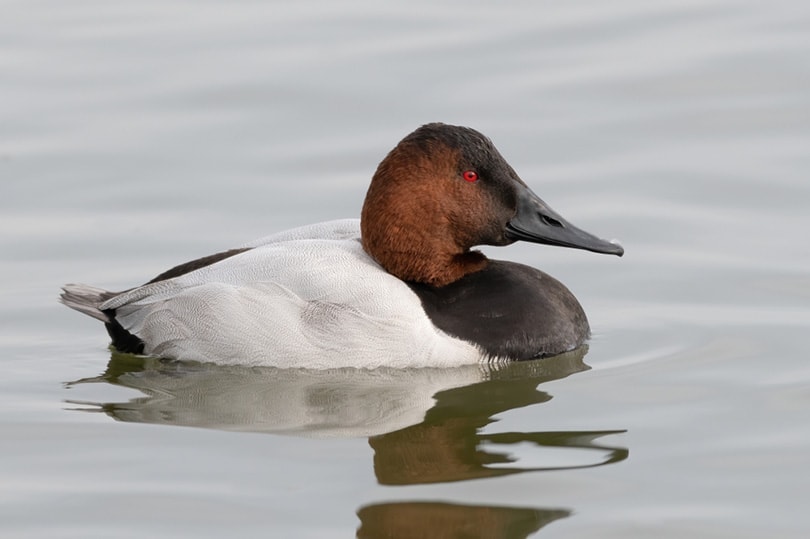
| Rarity: | Rare |
| Type: | Diving Duck |
You can start spotting Canvasbacks when they begin to migrate through Illinois for the winter. They usually stay close to the Mississippi River or near large ponds and lakes.
Male Canvasbacks have brown heads, flat black bills, and red eyes. Their bodies are pale gray, and they have a black chest and tail feathers. Female Canvasbacks have duller brown heads and a brown chest and gray body.
Not many Canvasbacks winter in Illinois. They also spend the majority of their time on the water, so they’re an especially rare sight to see.
6. Common Goldeneye Duck

| Rarity: | Uncommon |
| Type: | Diving Duck |
The Common Goldeneye migrates through Illinois. You can occasionally spot them in the winter along the Mississippi River, and on rare occasions, they stay in Illinois during the summer months.
The males have yellow eyes and sloping dark-green heads with white cheeks. The top of their bodies is black while the bottom is white. Females also have yellow eyes, but they have brown heads and gray-brown bodies.
7. Common Merganser Duck
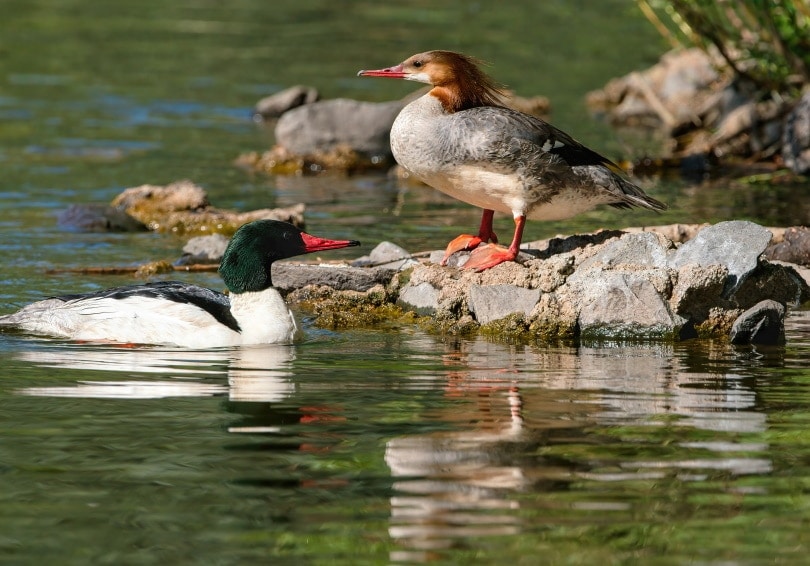
| Rarity: | Common |
| Type: | Diving Duck |
The Common Merganser winters in various locations in Illinois. You can often find them near ponds, sewage lagoons, rivers, and lakes.
These ducks are relatively large. The males have green heads and long and narrow bright orange bills and have mainly white bodies with black and gray accent feathers. The females have red-brown heads and gray and white bodies.
Common Mergansers enjoy eating small fish, and they work in teams to hunt their meals.
8. Gadwall Duck
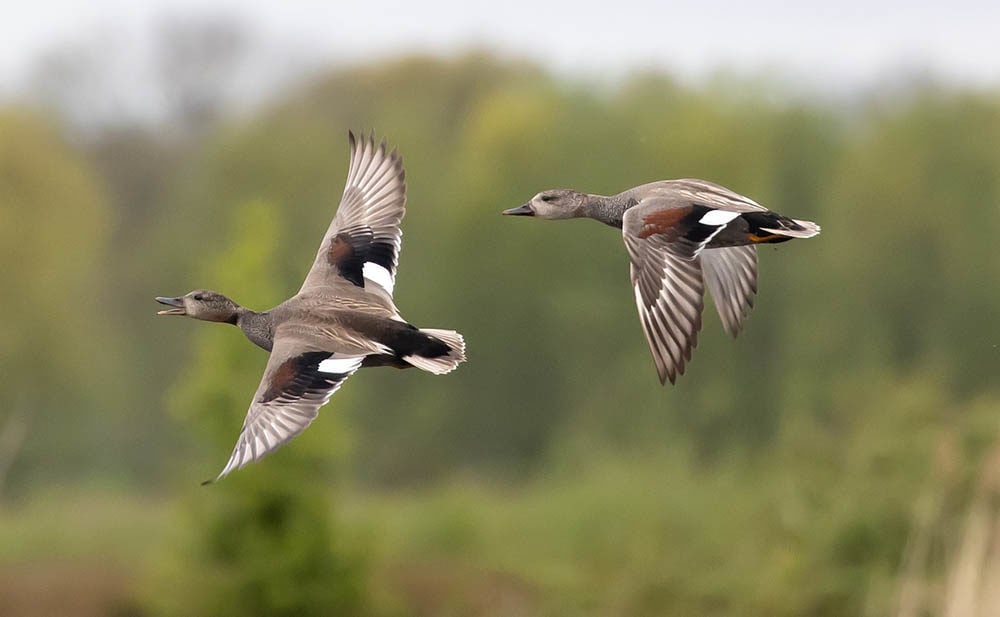
| Rarity: | Rare |
| Type: | Dabbling Duck |
The Gadwall flies through Central and Southern Illinois to winter in Tennessee and Louisiana. They prefer living near lakes, marshes, and ponds where they can feed on aquatic plants and small invertebrates.
Male Gadwalls have black bills, brown and gray bodies, and black tails. Female Gadwalls are mottled brown and have dark orange bills.
9. Green-Winged Teal Duck

| Rarity: | Uncommon |
| Type: | Dabbling Duck |
Green-Winged Teals are a rarer sight to see than their blue-winged counterpart. These ducks migrate through Illinois and may occasionally winter near the southern tip of Illinois.
You can typically find them in shallow waters and mudflats and feeding on aquatic plants, insects, and snails.
Male Green-Winged Teals have black bills and brown heads with a streak of green. They have gray and brown bodies and dark green wing patches. Female Green-Winged Teals also have green wing patches, but they have mottled brown heads and bodies.
10. Greater Scaup Duck

| Rarity: | Rare |
| Type: | Diving Duck |
These ducks migrate through Illinois, and if they choose to rest in-state, they’ll stick to living near large bodies of water.
The males have flat, gray bills and yellow eyes. Their heads are dark green, and they have black chests and tails, speckled gray backs, and white bodies. The females have brown heads with a white patch surrounding the bills. Their bodies are gray and light brown.
11. Hooded Merganser Duck

| Rarity: | Common |
| Type: | Diving Duck |
The Hooded Merganser lives in Illinois year-round. They prefer living near shallow ponds and rivers in the summer, and then they’ll move closer to deeper waters in the winter.
The males have round black heads with a bright white patch and yellow eyes. The top of their bodies is black, and the bottom is white, and they have brown wing feathers. Female Hooded Mergansers have mottled brown bodies and a crown of brown feathers on their heads.
12. Lesser Scaup Duck

| Rarity: | Common |
| Type: | Diving Duck |
The Lesser Scaup is a very common duck in Illinois. You can seek flocks of thousands of ducks gathered near large bodies of water.
The males have narrow black heads with yellow eyes and large, flat bills. They have specked feathers on top, black chests and tails, and white bodies. The females are dark brown and black and have speckled wing feathers.
13. Mallard Duck
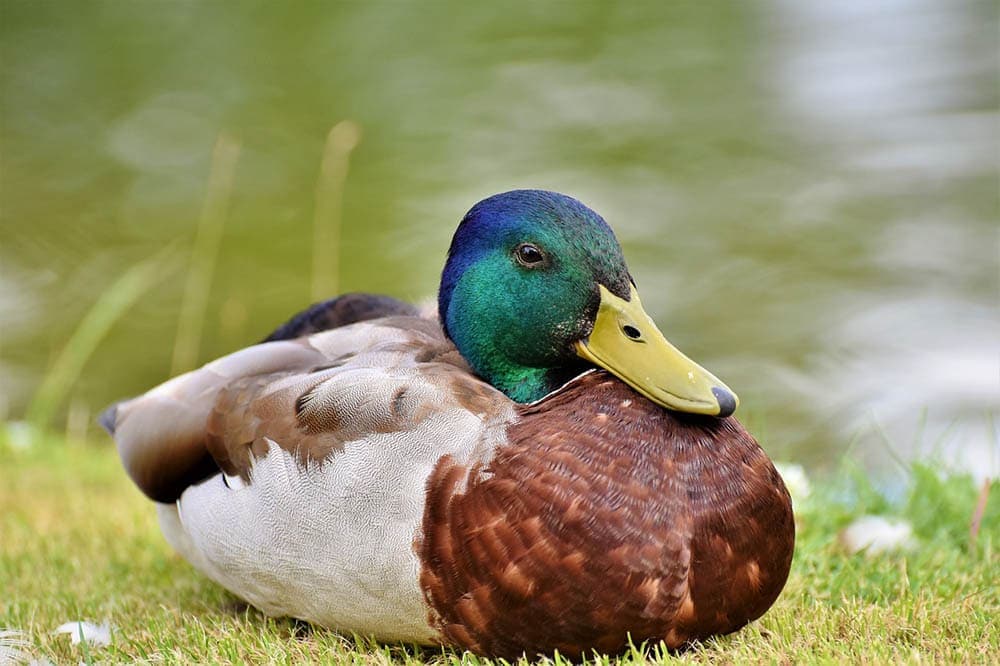
| Rarity: | Common |
| Type: | Dabbling Duck |
The Mallard is the most common type of duck that you can find in Illinois. They prefer shallow wetlands and lakes, but you can find them in small ponds and even in manmade fountains.
The male Mallard has a dark-green head, yellow bill, and orange feet, and his body has brown and feathers and black tail feathers. The females have a mottled brown pattern with brown or orange bills.
Most Mallards are fairly used to humans, so they’re not too shy and won’t fly away if you’re nearby.
14. Northern Pintail Duck

| Rarity: | Uncommon |
| Type: | Dabbling Duck |
The Northern Pintail migrates from Canada and flies through Illinois for the winter. They rest in Southern Illinois along the border of Missouri.
You can quickly spot a Northern Pintail because of its long neck and upright tail feathers. Male Northern Pintails have round brown heads and flat black bills. Their bodies tend to be speckled and have white, gray, and black feathers. Females have mottled brown feathers and shorter tail feathers.
15. Northern Shoveler Duck

| Rarity: | Rare |
| Type: | Dabbling Duck |
It’s pretty rare to spot this duck because they spend the winter in the coastal regions near the Gulf of Mexico and Central America. However, you can sometimes catch them on the southernmost tip of Illinois in the wintertime.
Male Northern Shovelers have iridescent green heads and extremely large flat bills. Their chests are white, and they have brown wing feathers and black tail feathers. Female Northern Shovelers are mottled brown and have the same flat, broad bills, but they’re orange.
16. Red-Breasted Merganser Duck

| Rarity: | Rare |
| Type: | Diving Duck |
These ducks migrate through Illinois as they breed in Canada in the summer and winter in Central America. They can live near freshwater and saltwater lakes and wetlands.
Males have dark green heads with a crown of long black feathers sitting on top. They have chestnut-colored chests and black and white body feathers. Females are gray and brown and also have a crown of feathers.
17. Redhead Duck
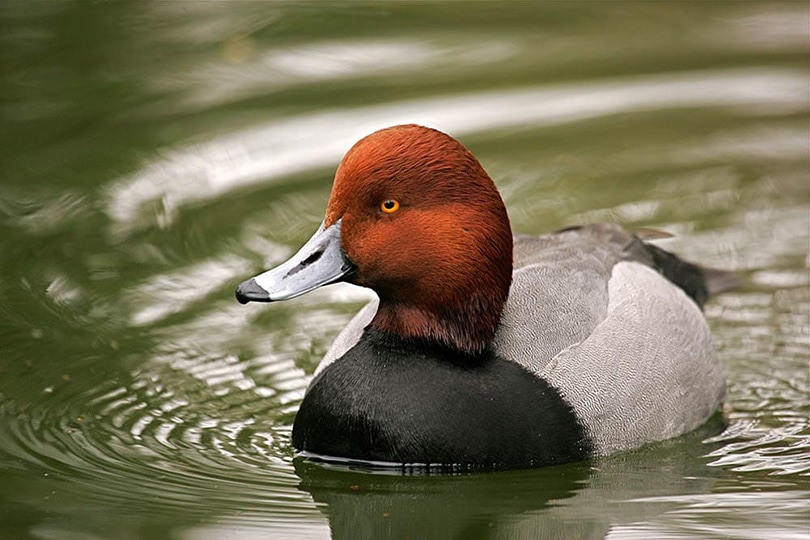
| Rarity: | Rare |
| Type: | Diving Duck |
Redheads fly through Illinois to winter in Florida, and they fly through again to reach the northern states for the breeding season.
Males have cinnamon-colored heads and a flat, sloping bill. They have brown chests and tails and specked feathers on their bodies. Female Redheads don’t have any red feathers. Instead, they have a muted, mottled brown pattern.
18. Ring-Necked Duck

| Rarity: | Uncommon |
| Type: | Diving Duck |
These ducks migrate through Illinois and occasionally winter in Central and Southern Illinois. You can find them living in swamps, marshes, overflow areas, and lakes.
The males are black and white and have flat bills with white stripes on them. The females have a cinnamon-brown color.
19. Ruddy Duck
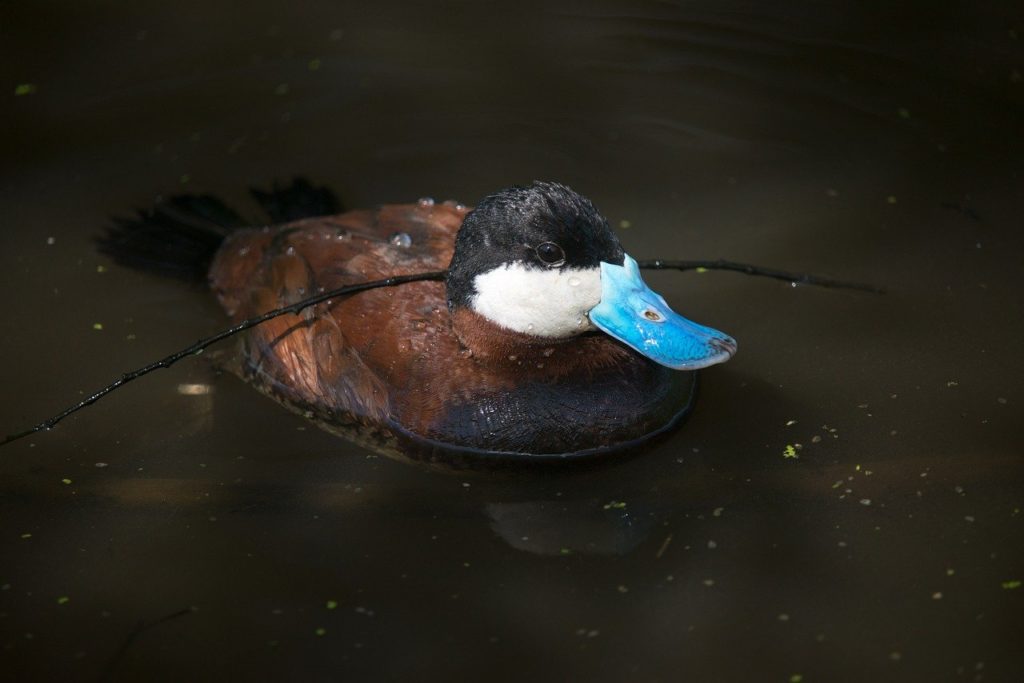
| Rarity: | Common |
| Type: | Diving Duck |
These ducks migrate through Illinois, and you can find them resting all throughout the state during migration. There’s also a small breeding population in Northern Illinois.
They aren’t very great at walking on land, and they waddle clumsily. Instead, they’re experts at navigating through water, and they also build floating nests securely attached to nearby plants.
Male Ruddy Ducks have black and white heads and a flat, bright blue bill. Their bodies are cinnamon-colored, and they have a long set of black tail feathers. Female Ruddy Ducks have brown heads and bodies, and their flat bills are also brown.
20. Wood Duck
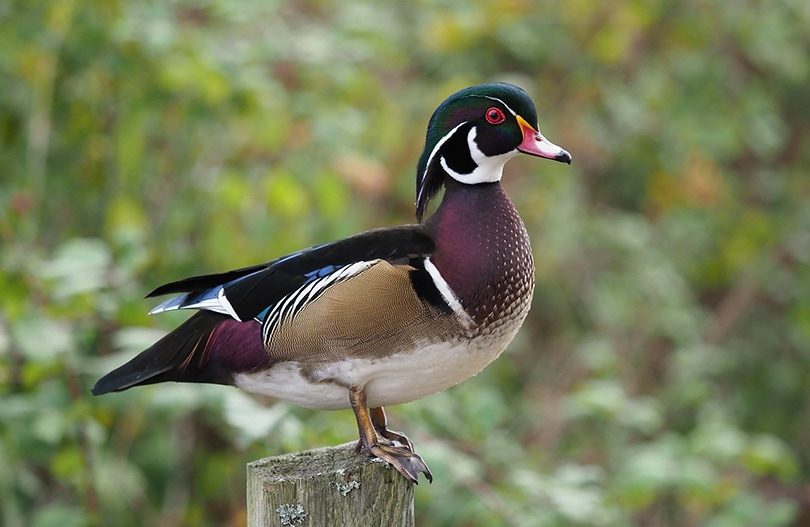
| Rarity: | Common |
| Type: | Dabbling Duck |
You can spot the Wood Duck all throughout Illinois. These ducks are common residents of the state and stay year-round in wooded areas with bodies of water, such as streams, ponds, and rivers.
Male Wood Ducks have one of the most intricate patterns. They have green crowns, brown and black heads with white stripes throughout. Their eyes and bills are red. Their chests are maroon, and the rest of their bodies have iridescent feathers that are green, purple, and brown. Females have dark gray-brown feathers and white belly feathers. They also have some white feathers surrounding their eyes.
Related Read: 7 Species of Woodpeckers in Illinois

Conclusion
Since Illinois is located in the Midwest, it’s a central location for many duck breeds to fly through as they migrate. If you look in the right habitats, you can spot some of these seasonal guests passing through during different parts of the year.
Ducks have long cross-country and cross-continental journeys. So, the next time you see some ducks, make sure to stop and take some time to admire and appreciate these tough birds and the hard work they do to keep their ecosystems thriving.
Featured Image Credit: AnnaER, Pixabay
Table of Contents
- The 20 Duck Breeds in Illinois:
- 1. American Black Duck
- 2. American Wigeon Duck
- 3. Blue-Winged Teal Duck
- 4. Bufflehead Duck
- 5. Canvasback Duck
- 6. Common Goldeneye Duck
- 7. Common Merganser Duck
- 8. Gadwall Duck
- 9. Green-Winged Teal Duck
- 10. Greater Scaup Duck
- 11. Hooded Merganser Duck
- 12. Lesser Scaup Duck
- 13. Mallard Duck
- 14. Northern Pintail Duck
- 15. Northern Shoveler Duck
- 16. Red-Breasted Merganser Duck
- 17. Redhead Duck
- 18. Ring-Necked Duck
- 19. Ruddy Duck
- 20. Wood Duck
- Conclusion
About the Author Robert Sparks
Robert’s obsession with all things optical started early in life, when his optician father would bring home prototypes for Robert to play with. Nowadays, Robert is dedicated to helping others find the right optics for their needs. His hobbies include astronomy, astrophysics, and model building. Originally from Newark, NJ, he resides in Santa Fe, New Mexico, where the nighttime skies are filled with glittering stars.
Related Articles:
Monocular vs Telescope: Differences Explained (With Pictures)
10 Types of Hummingbirds in Arkansas (With Pictures)
8 Types of Hummingbirds in Nebraska (With Pictures)
5 Types of Hummingbirds in Idaho (With Pictures)
3 Types of Hummingbirds in Mississippi (With Pictures)
8 Types of Hummingbirds in Kansas (With Pictures)
5 Types of Hummingbirds in West Virginia (With Pictures)
5 Types of Hummingbirds in Ohio (With Pictures)
